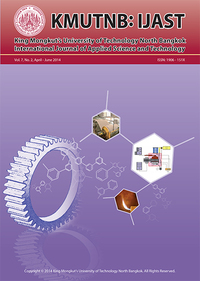Energy and Exergy Analysis of Steam Boiler and Autoclave in Fiber Cement Process
Main Article Content
Abstract
The fiber cement composite production process consumes extremely high fuel especially boiler and autoclave leading to the release of a lot of waste energy. In this study, the concept of energy and exergy utilization is analyzed and illustrated in the form of the Sankey diagram. It was found that the energy and exergy efficiencies of the boiler were 72.04 and 69.98%, respectively. The exergy destruction of the boiler system is 30% or 3.89 MW. Which can also be represented in the Power Available Diagram (PAD). In the exergy analysis, there are 2 methods in reducing the energy loss of the boiler by increasing the steam outlet temperature or reducing the temperature of the exhaust gas of the boiler. For the autoclave system, the energy analysis showed the total energy input at 43.67 GJ/batch. The three main energy losses are; the exhaust steam (49.74% or 23.74 GJ/batch), condensate (16.42% or 7.83 GJ/batch) and autoclave shell heat loss (13.67% or 6.25 GJ/batch). For the exergy, the exergy destruction in the autoclave is at 87.14%. However, the PAD of the autoclave cannot present the relation of the exergy loss. The main causes of the exergy destruction are the three main energy losses; the exhaust steam (50.80%), condensate (16.47%) and autoclave shell loss (10.01%) respectively.
Article Details
How to Cite
Bouapetch, W., Rohitatisha Srinophakun, T., Prakaypan, W., & Paterson, A. (2014). Energy and Exergy Analysis of Steam Boiler and Autoclave in Fiber Cement Process. Applied Science and Engineering Progress, 7(2), 37–46. retrieved from https://ph02.tci-thaijo.org/index.php/ijast/article/view/67436
Issue
Section
Research Articles


